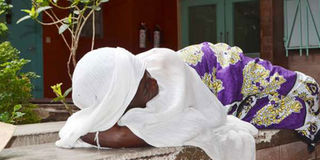Strike pushes clinicians to extra duties

A woman sleeps outside the Coast General Hospital where her sister is admitted, on January 19, 2017. Doctors are still on strike. PHOTO | KEVIN ODIT | NATION MEDIA GROUP
What you need to know:
- The Council of Governors Health Committee met with the Kenya Union of Clinical Officers (Kuco) and Kenya Health Professional Society and set up a taskforce to look into the pleas that the clinicians tabled to their employers.
- In the dry harsh weather of Kacheliba in West Pokot, a government run level four hospital stands. In the whole county, Kacheliba Hospital is the only one that offer anti-venom to the lethal snake bites, a common problem in this area. It is also the only facility that can treat Kalazar, a mosquito-caused disease that thrives in the warmth, heat and the malnutrition of this area.
- According to Dr Michael Makari, the deputy superintendent of the facility, the four clinical officers handle the Kalazar clinic, see patients that visit the hospital every day and administer medication to those in wards.
As the ongoing doctors’ strike keeps medics away from the hospital, clinical officers have been forced to take on extra work, a stability that was threatened when they also issued strike notice. The clinicians called off their strike that could have begun on Monday.
The Council of Governors Health Committee met with the Kenya Union of Clinical Officers (Kuco) and Kenya Health Professional Society and set up a taskforce to look into the pleas that the clinicians tabled to their employers.
Kuco Secretary General George Kibore told Sunday Nation: “We have held the facilities together, conducting as much as caesarean surgeries and handling emergency services.” He said clinicians are doing a commendable work.
In the dry harsh weather of Kacheliba in West Pokot, a government run level four hospital stands. In the whole county, Kacheliba Hospital is the only one that offer anti-venom to the lethal snake bites, a common problem in this area. It is also the only facility that can treat Kalazar, a mosquito-caused disease that thrives in the warmth, heat and the malnutrition of this area.
According to Dr Michael Makari, the deputy superintendent of the facility, the four clinical officers handle the Kalazar clinic, see patients that visit the hospital every day and administer medication to those in wards.
“...these four clinicians had to step into nursing, handling the motorbike emergencies and outpatient services,” Dr Makari said.
Clinicians are trained on diploma for three years or a four-year degree, both with a one year compulsory internship. At the end of their training they are capable of surgeries such as cataract, caesarean, orthopedics, anaesthesia among others.
Last time Sunday Nation visited Kacheliba Hospital mid last year, clinician Mark Riongota looked after more than 26 patients in the Kalazar ward. As it is now, he has more duties to carry out.
Initially his work was to prepare patients for referral to the Level 5 facility in the area—Kapenguria Hospital— for crucial surgeries. Now, he and Dr Makari have been forced to establish a new relationship across the border— Amudat Hospital in Uganda— which is a tiring journey for any patient in need of referral because of the near existent road network.
Random data collected by Sunday Nation in public hospitals in areas with no private facilities showed a reduction of patient traffic to facilities which raises the questions of the social impact of the strike.
According to Dr Lukoye Atwoli, Dean Medical School of Moi University analysing the psychosocial and economic impact of this strike would take into account at least changes of outpatient traffic to hospitals, bed occupancy and monies charged.





